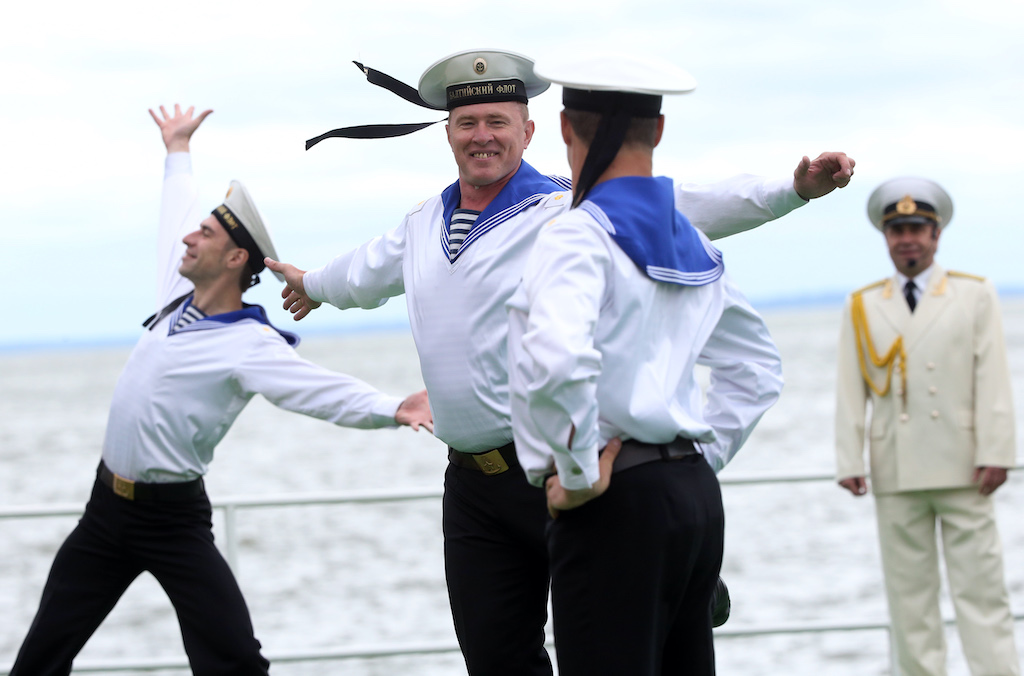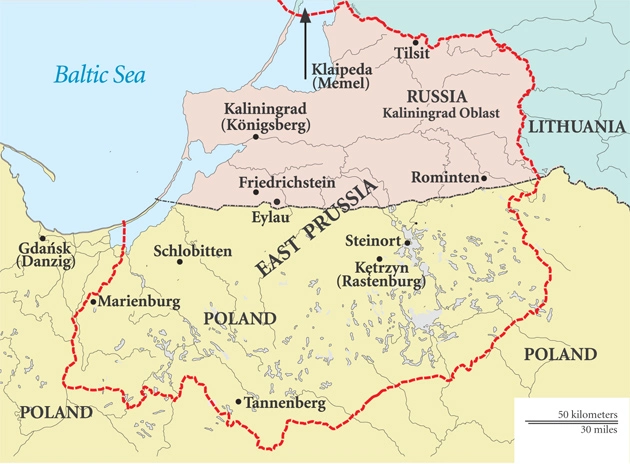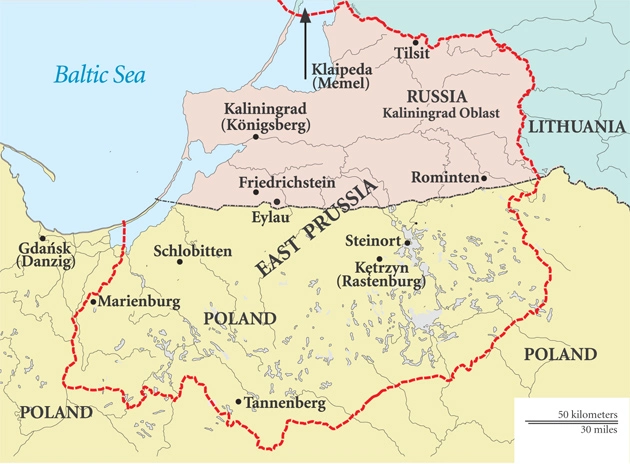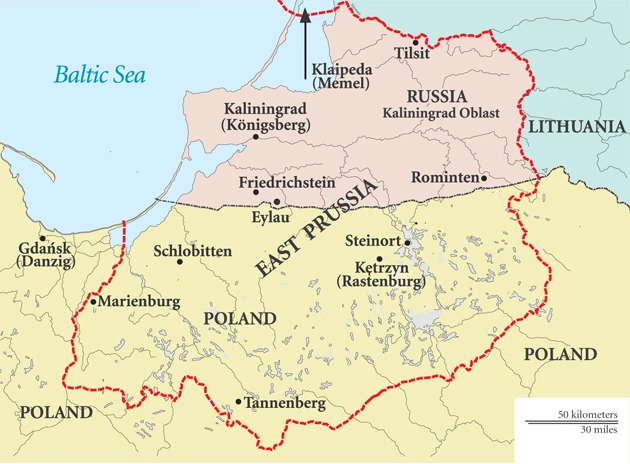Germany, East Prussia - Kaliningrad oblast, and Russia - Ukraine War 2022
- Lithuania: We’re ready if Russia cuts us out of common power grid over Kaliningrad disruptions Reuters
- Why is Lithuania risking Russia’s wrath over Kaliningrad? Yahoo News
- Why Kaliningrad, Russia’s toehold in Europe, could be the next flashpoint in its war against Ukraine CNN
- Kaliningrad Has Spelled Trouble Throughout European History Bloomberg
- Moscow’s response to Lithuania over transit ban won’t be only diplomatic -official Reuters
- View Full Coverage on Google News
Germany, East Prussia - Kaliningrad oblast, and Russia - Ukraine War 2022 - Post Link

Russia’s exclave in Kaliningrad has long given nightmares to NATO’s defense planners. The outcome of the Ukraine war will bear heavily on its future.
 The Kaliningrad garrison serves as an intimidating Russian presence in the Baltic region. The Baltic Fleet, headquartered there, has been significantly upgraded in recent years with new ships, ground forces and missiles. © Getty Images
The Kaliningrad garrison serves as an intimidating Russian presence in the Baltic region. The Baltic Fleet, headquartered there, has been significantly upgraded in recent years with new ships, ground forces and missiles. © Getty Images- The outcome of the war in Ukraine may seal the future of Kaliningrad
- Russia’s military forces serve as a lock on the Baltic
- The exclave may morph from Moscow’s strategic asset to a liability
NATO military planners have long been concerned about Russia’s strategic Kaliningrad exclave. Wedged in between Poland and Lithuania, the chunk of Russian territory with fewer than half a million people has been a fixture in the security architecture of the Baltic Sea region. During the years leading up to the 2022 war in Ukraine, major Russian moves to upgrade its military presence there have triggered concerns. The scenarios hinge on how that war ends and if the regime in Belarus survives.
The heightened posture featured the introduction of Iskander ballistic missiles that may carry nuclear warheads, combined with Russia’s top-of-the-line S-400 air defense systems and Bastion coastal defense systems. Meanwhile, the ground forces were enhanced with new units, including more and better tanks and artillery. And the Baltic Fleet, also based in Russia’s westernmost town of Baltiysk, received both upgrades and additional ships.
As Russia’s “special military operation” in Ukraine continues to reveal disastrous shortcomings, it is becoming questionable how much of this still matters and if Kaliningrad will play much of a role in the future.
Kaliningrad exclave’s military significance
The main reason why NATO has been so concerned has to do with the exposed position of the two northern Baltic states. As shown in numerous war-gaming exercises, a Russian armed invasion of Estonia, for example, could have been swift and would have presented NATO with a fait accompli. Once it failed to repel the attack, the alliance would find itself in an unenviable position of having to expel the invader to honor its mutual defense obligations under Article 5.
If such a rescue were to be launched over land, it would have to proceed from Poland into Lithuania. NATO forces would need to transit the “Suwalki Gap,” a 70-kilometer stretch of land between Kaliningrad and Belarus, and the opposition would heavily bombard it from both sides. The alternative would be a combined airlift and naval convoy proceeding up the Baltic past Kaliningrad’s missile batteries.
Given that NATO assets attempting to pass through that area would have had to reckon with heavy losses, Kaliningrad served as an intimidating Russian lock on the Baltic. In military jargon, it was an “A2/AD (anti-access/area denial) bubble.” Adding that a Russian attack on one or more Baltic states would likely have been associated with a Russian assault to seize the demilitarized Swedish island of Gotland, strategically located in the center of the Baltic, the double lock seemed to be quite formidable.
With NATO troops present on the ground in Finland, the Russian rear would be dangerously exposed to missile and artillery strikes.
Although no NATO source would have admitted this possibility, Moscow may well have calculated that if it did choose to invade, say, Estonia, NATO would seek and find an excuse to settle the matter without the use of force. In the case of Finland and Sweden in NATO, that calculus changes beyond recognition.
Enter Finland and Sweden
It is true that Russia has long viewed both countries as de facto NATO members and that despite their nonaligned status, NATO troops would still have been able to come to the rescue of the Baltics via the Swedish and Finnish territories. But there are three important points to be made here.
One is that with NATO troops present on the ground in Finland, the Russian rear would be dangerously exposed to missile and artillery strikes. Another is that the Swedish and Finnish air forces, which now have ample experience in joint operations, would constitute a formidable problem for Russian aviation. And the third important circumstance is that the Swedish navy has advanced submarines that could swiftly take on the dual task of eliminating any Russian naval opposition and aggressively mining the approaches to St. Petersburg, including the Russian naval base in Kronstadt.
This enhancement in the ability of NATO to protect Estonia and Latvia will significantly reduce the importance of Kaliningrad. While this will erode the incentive for Russian military planners to invest in keeping it up to scratch, the garrison there will remain consequential. It retains its strategic location in the southern Baltic, and it has the capability of launching nuclear missile strikes against Warsaw, an option that has featured in war games.
However, from the Kremlin’s distant horizon, Kaliningrad could be transformed from an asset into a liability. The outlook features very different scenarios where the critical feature concerns what will happen in Belarus.
Pushing back Russia
The first scenario emerges if a decisive Russian defeat in Ukraine leads to a collapse of the regime of strongman Alexander Lukashenko. A cessation of economic support from Russia to Belarus could prompt a cascading crisis, strikes and civil unrest, with parts of the armed forces eventually switching their allegiance. Battle-hardened Belarusian volunteer forces that have fought against the Russians in Ukraine could be decisive here, returning home to help expel all remaining Russian troops from Belarus.
If Belarus switched sides, the consequences for the Russian garrison in Kaliningrad would be immense. Already depleted from having contributed troops to the war in Ukraine, the military outpost would find itself surrounded by hostile forces. As Russia’s borders in the West would be pushed back to roughly where they were at the end of the 16th century, the “Suwalki Gap” would cease to matter. Lines of communication between Poland and Lithuania – and points further north – would be wide open.
Defense consequences
Having already declared Russia a terrorist state and branded Russian warfare in Ukraine as genocide, the government in Lithuania could be expected to join Poland in putting a squeeze on Kaliningrad. It would not result in the exclave becoming formally demilitarized, but, over time, the situation of its garrison would come to resemble that of the Russian outpost in Transnistria in Moldova.
The military would become degraded. Even if Russia had resources to spare for Kaliningrad, which is doubtful, military planners would be constrained by the prohibition of transporting troops or military hardware over land. With the Baltic Sea in the hands of NATO, resupply by sea would be at the mercy of the alliance. With sophisticated missiles stationed on the Swedish island of Gotland, the airspace would also belong to NATO.
Economic deterioration
The exclave’s economy would become equally degraded. The sanctions regime would block all forms of imports over land, leaving shipping as the only lifeline, and Russian ships would have a hard time finding foreign ports at reasonable distances that would receive them. Shortages would become ubiquitous.
In consequence, the local population would find everyday life increasingly complicated. Those employed in the dominant military sector would feel the squeeze of dwindling payments from Moscow. At the same time, those living off border trade would no longer be able to continue such operations.
Under this broad scenario, Kaliningrad would fizzle into irrelevance. With its nuclear weapons eventually removed, the Baltic Sea region would enjoy peace and stability.
Russia prevails
An alternative scenario would occur if the Western resolve to stand by Ukraine erodes over time, and Kyiv is forced to accept a settlement. A deal between the European Union and Russia could end hostilities and cause a withdrawal of Russian forces from much of Ukraine. The price for that would be allowing the Kremlin to retain control over the Crimean Peninsula and Donbas (at least), plus most likely also the coastline up to, and possibly even beyond, Crimea.
Such an outcome would allow the Russian regime to save face, thus removing the threat of regime change via a coup. It would also be associated with a gradual lifting of sanctions to allow Russia to resume cooperation with its former European partners. And it would be associated with Belarus remaining within the Russian camp, fostering even deeper bonds between the two militarized autocracies.
If the Lukashenko regime survived, it may be expected to deal harshly with those who sought to undermine the Russian war effort in Ukraine, ranging from volunteer forces to railway saboteurs and civil society activists. Increased repression would feature the use of the recently reintroduced death penalty and possibly even assassinations of opposition figures abroad. The potential implications for Kaliningrad are considerable.
Regaining strength
As Russia recovered its economic strength, buoyed by continued energy exports to Europe and a resumption of trade that has European industry majors returning to the Russian market, it would also be able to start rebuilding its military capabilities. Embittered by its humiliation in Ukraine, the Kremlin would be prone to use the Belarus-Kaliningrad axis to drive home that its voice must still be heeded.
Given that a negotiated settlement of the war would still be associated with a heavy buildup of NATO forces along Russia’s western borders, and that its conventional military hardware has proven inferior to NATO weapons, Russian planners would be escalating their already loud nuclear saber-rattling.
Kaliningrad would be assigned a critical role in this endeavor. The exclave’s land-based Iskander missiles constitute a lethal threat to Poland. The Baltic Fleet has missile corvettes that may launch nuclear-capable Kalibr cruise missiles capable of striking land targets at 1,500-2,500 kilometer-distance and Kh-35 cruise missiles that may strike enemy ships. If these forces are maintained and upgraded, peace and security in the Baltic Sea region come under a very dark cloud.
Perpetual threat
A middle-of-the-road outcome is possible, where Russia suffered a decisive loss in Ukraine, but Belarus still manages to muddle through. Under this script, the country offers the Kremlin a vantage point to extend future influence toward Kaliningrad and the EU. But it would be a weak link, in constant danger of breaking.
The obvious alternative to a clear Russian defeat is a dubious deal. Western resolve could dissipate over time. The leading European powers may succeed in brokering a “peace” plan that would allow Russia to retain a hold over Ukraine and Belarus to remain in the Russian camp. This scenario ensures access to resources for Russian leaders bent on seeking revenge.
Michael Novakhov


A former American national security adviser once called Kaliningrad, a Russian enclave sandwiched between the NATO members Poland and Lithuania, “a dagger in the heart of Europe.”
Now Kaliningrad, a port city captured from the Nazis by the Soviet Union during World War II, once again finds itself a fault line in a Cold War-style conflict between Russia and the West.
The Russian authorities this week threatened Lithuania with retaliation if the Baltic country did not swiftly reverse its ban on the transportation of some goods to Kaliningrad by rail. The restrictions exposed the geopolitical vulnerability of Kaliningrad, which is Moscow’s westernmost outpost but more than 200 miles from mainland Russia.
Russia’s invasion of Ukraine has stoked tensions in the region, where memories of Soviet subjugation run deep.
As nationalist rhetoric has grown more intense in recent years, Russia has moved advanced Iskander missiles into Kaliningrad, which is on the Baltic Sea. Lithuania’s defense minister said in April that Russia had stationed nuclear weapons in the region, which Moscow denies.
Having invaded Ukraine and deployed its troops to its pliant ally Belarus, Russia has suddenly flexed its military muscle near the borders of several NATO countries, including Baltic nations. Only a thin corridor between Lithuania and Poland, about 60 miles long, separates Russian forces in Belarus from Kaliningrad.
While analysts say that Moscow, already overextended in Ukraine, is unlikely to provoke another war in Europe, any attack on a Baltic state would trigger NATO’s mutual defense treaty. And any attempt to defend them would have to get past Kaliningrad and the missiles stationed there.
There was a time when Russia touted Kaliningrad as a symbol of its links with European culture. In the 1990s, the Russian authorities promoted Kaliningrad’s past ties to Germany to help attract tourists, lauding its role in the life and work of the 18th-century German philosopher Immanuel Kant, who was born and lived in Königsberg, the regional capital now named Kaliningrad. (The Soviet authorities renamed the city in 1946 after Mikhail Kalinin, a Bolshevik revolutionary.)
The city has had other high-profile residents: Lyudmila Ocheretnaya, the former wife of President Vladimir V. Putin of Russia, was born there.
In the immediate post-Soviet era, Moscow tried to reinvent Kaliningrad as its own duty-free Hong Kong. The region sprouted with factories producing cars, electronics and furniture. After the provincial government negotiated visa-less travel to Polish border areas, the Ikea outlet in nearby Gdansk, Poland, became a popular destination for Russians.
But Moscow historically has also sought to obfuscate Germany’s historical ties to the area. In the 1960s, the Soviet authorities blew up a still-standing portion of a Gothic castle to make way for the House of Soviets, a towering building meant to symbolize the Soviet Union’s control over former German territory. Instead, the building was marred by structural defects, was never fully occupied and became a monument of sorts to Soviet failure.
The latest flare-up with Lithuania is not the first time Kaliningrad has been the locus of tensions.
In 2016, about 70 nautical miles off Kaliningrad, two Russian Su-24 planes buzzed the American guided missile destroyer Donald Cook, simulating an attack and drawing protests from Washington.
In another episode that same month, a Russian warplane intercepted an American reconnaissance plane at an unsafe distance over the Baltic Sea.

NGS Image Collection/Art Archive/Art Resource
Marienburg Castle, the former headquarters of the Teutonic Order, Marienburg, East Prussia, 1928. The castle, in what is now Poland, was damaged significantly during World War II, but has since been mostly reconstructed.
German history has a Stunde Null, a zero hour. It applies to the capitulation at midnight on May 8, 1945, or more generally to the end of World War II. Germans experienced the unconditional surrender of the National Socialist state amid unprecedented destruction of the existing built environment, political system, and cultural order, mass mental trauma, and social and economic dislocation. In fact, much soon returned to relative normality, helped by the thorny process of denazification, which was always more thorough for institutions and ideas than for personnel. Whether in the western and southern regions, soon to be reconstituted as the Federal Republic, or in the zone of Soviet occupation, soon to become the Democratic Republic, the future would still, like the past, be a German one.
The real Stunde Null occurred hundreds of kilometers further east. There, the future parted company with the past. East Prussia had always been a bastion, a far-flung realm of Germandom, ever since its foundation on distant shores of the Baltic (the Ostsee, or eastern sea, as Germans call it) by the Teutonic Knights seven centuries earlier (see map on page 56). Its name of “Prussia,” originally derived from an indigenous tribe, was then descriptive of terrain standing under the Polish crown. The word came by stages to be applied loosely to the whole Germanic kingdom of the Hohenzollern dynasty, as promulgated by a first coronation—of Frederick I—in Königsberg, Prussia’s chief city, in 1701.1
For all its later extension to the Rhineland and much of middle Germany, the old heartlands of Prussia in the East continued to furnish the country’s stereotypes.2 Noble landowners (“Junkers”) and great estates supplied a vital part of its ethos—and liability; so did a Lutheran church much given to pietistic forms of devotion. Such values were sustained into the twentieth century by tariff concessions for landowners and subsidies for Protestant organizations.
Historic Prussia also embodied, psychologically and culturally, German claims to dominance. For what Nazi ideologues came to prize as “blood and soil,” Blut und Boden, the organic linkage of race with territory, East Prussia was crucial, even if plenty of Germans also shared Frederick the Great’s view of a remote and primitive province more suited to bears than humans. So it was symbolic, as well as strategic, that Hitler relocated to East Prussia (however much he allegedly preferred the Alps), and spent two thirds of his time there in the years after the invasion of the USSR in June 1941. Near Rastenburg he had his “wolf’s lair,” the Wolfsschanze,3 built to his own designs. That is where, on July 20, 1944, the most celebrated and promising attempt was made by Hitler’s fellow citizens to assassinate him, a plot involving several local Prussian aristocrats, although the area had already been readily and heavily Nazified before the war.
As German defeat became—to all but the most fervent Nazis—inevitable and imminent, East Prussia faced not just destruction but extinction. It had been the only part of the country invaded and laid waste during World War I, a foretaste of worse to come. The writing was already on the wall in the late summer of 1944, when devastating British bombs rained down on Königsberg. The situation was then aggravated precisely because the city had to be defended to the last, by the Führer’s express order. As winter melted into spring, the reckoning neared for five years of wartime carnage—and nemesis for centuries of German policy in the East. There followed invasion by the Soviets, the siege of Königsberg, the final assault, then capitulation on April 9. After that, the deluge. Königsberg, renamed Kaliningrad, became part of Russia.
Max Egremont’s book memorably captures the atmosphere of the calm before the storm. He tells the tales of people who witnessed that Stunde Null, and who wrote and spoke of it later. He recreates a world that was suddenly, brutally, and comprehensively swept away, and he examines aspects of its legacy, as personified in survivors.
There are some famous dramatis personae. In the earlier twentieth century East Prussia was associated with Paul von Hindenburg, commander of the German army that recovered the province from the Russians in World War I, who later settled there as president of the Weimar Republic, on a historic family estate bought back for him by a grateful nation; with the radical graphic artist and sculptress Käthe Kollwitz, a native of Königsberg; and with the novelist Thomas Mann, who discovered the Prussian coast and had a house near the sea at the height of his fame, and only shortly before he had to flee Hitler’s Reich as a dissident.
In the last weeks of World War II another dissident, Alexander Solzhenitsyn, while a Soviet officer, was arrested there, for ridiculing Stalin in a private letter, and sentenced to the Gulag. Above all, East Prussia had an iconic figure from the Age of Enlightenment: Immanuel Kant, whose philosophical investigations embraced physical and mental universes and changed the whole course of human thought through Europe and beyond, but who over a long life—he died in 1804 aged seventy-nine—never journeyed more than ten miles from Königsberg.
Egremont’s main source has been a chain of memoirists and informants, some of whose work became best sellers in Germany while remaining little known further afield. He presents a colorful gallery of witnesses, and includes members of the three great East Prussian aristocratic clans: the Dohnas, whose palace at Schlobitten, regularly visited by the Hohenzollerns, was packed with treasures, including a library of over fifty thousand volumes (though they apparently required their librarian to be a horseman too); and the Dönhoffs and Lehndorffs, who lived in similar style at Friedrichstein and Steinort respectively. Egremont provides a sensitive and poignant recreation of their world.
But he is no less at ease with such characters as the part-Jewish musician Michael Wieck; the British army officer Alfred Knox; the museum curator Lorenz Grimoni; the dyspeptic reactionary Elard von Oldenburg-Januschau; the poetess Agnes Miegel, who sailed too close to the Nazi wind; the Lutheran pastor Johannes Jänicke, who tried to understand and conciliate the invaders; the huntsman Walter Frevert, keeper of Hermann Goering’s huge game forest at Rominten; and the German Communist poet Rudolf Jacquemien and the Russian writer Yuri Ivanov, both of whom would seek to rebuild some cultural traditions after the war. He draws on the recollections of two of the last survivors of the old East Prussia, Martin Bergau and Klaus Lunau, boys at the time of Armageddon. Bergau was a member of the Hitler Youth who later wrote of German atrocities against Jews. Lunau, married to a Russian, lives half the year in his old hometown of Cranz, near Kaliningrad, and edits a journal called Our Beautiful Samland.
Egremont’s strength lies in his intricate interweaving of episodes still, or until recently, within living memory. There is a much larger picture, and a much lengthier process, that he only hints at. The Germans of East Prussia made up a small proportion of the nation.4 Whereas they were clearly part of the German Fatherland in its later nineteenth-century form, as united by Bismarck, they had never belonged to its predecessor, the Old, or Holy Roman, Empire. When they traveled to the rest of Germany they continued to speak of “going into the Reich,” the more so after the defeat in 1918, when a “Polish corridor”—an area to the west of the great port of Danzig (Gdańsk), which became a free city—again divided them from it. As such they can stand for millions more Germans across the east of Europe who are nowadays in danger of oblivion, like the “forgotten land” of which Egremont writes.
Successive waves of settlement began in the high Middle Ages, but continued later, an itinerant urge that marked out Germans as Europe’s greatest internal migrants until their steps were gradually redirected in modern times toward the New World. Most moved voluntarily, some involuntarily; they were attracted by colonial opportunities but also driven forth by poverty or persecution. Peasants and artisans predominated; but military groups, such as the Prussian Knights, took part in the movement eastward as well, along with larger landowners. Some went beyond Prussia, like the Baltic barons and soldiers who supplied a notable contingent of top tsarist administrators and generals as late as 1914, and the millions of simple colonists spread across the endless steppes of Russia.
Politically, many of these settlers remained more or less autonomous for centuries. The Teutonic Order, with its Prussian patrimony, represents an extreme case. But others formed part of German-dominated lands, often inside constituent territories of the multiethnic Habsburg monarchy. Rural pioneers would be attracted by legal contracts guaranteeing them a degree of immunity from dues and obligations. Above all, the colonists supplied an urban organization and ethos to a network of sturdy municipalities across the whole region, which within their town walls and gates dispensed justice according to principles and procedures already developed within German cities, especially Magdeburg.
Some of these groupings afford clear parallels with the East Prussian case so carefully reconstructed by Egremont. The Germans latterly known as Sudeten Germans, of the Bohemian lands, with their own powerful aristocracy, maintained for hundreds of years a kind of semidetached relation to the rest of Germandom. The so-called Saxons in a corner of Transylvania constructed a freestanding, tight-knit, burgher-dominated community, which embodied Lutheran qualities of diligence, exclusivity, and a tendency to self-righteousness.
A peasant equivalent was the Germans attracted to Russia by Catherine the Great and settled for generations in the Volga basin (two thousand miles from their old homeland): in the end they briefly achieved their own autonomous republic within the USSR. Their chief towns were then renamed “Engels” and “Marxstadt”—reminding us of the most important German impact in the intellectual sphere upon twentieth-century East Europe.
Later proponents and detractors of German settlements would speak, in an untranslatable and usually untranslated phrase, of a Drang nach Osten, or “drive eastward,” with strongly nationalist overtones. In fact, however, it was coexistence with other inhabitants that long marked the German presence in the East. Egremont cites the southern region of East Prussia, which came to be called Masuria,5 where there were always many Poles, or at least Polish-speakers. Most of them remained loyal to the Prussian state, and even became freely assimilated to the Protestant values of their German neighbors. Such patterns were replicated elsewhere, with ethnic criteria secondary and mutable. Some historians of the area have recently claimed that most ordinary people were indifferent to any form of explicit national allegiance until a very late stage.6
Besides, there were devices to minimize friction. Towns might have distinct guilds and council representation for various linguistic groups, as they might for religious ones (or for the makers of divergent styles of jackets and boots, for that matter). And at the elite level, a conceptual harmony reigned in this regard. Kant and his most influential pupil, Johann Gottfried Herder, were cosmopolitans, men of the broad movement of Enlightenment in Central European learning known as Aufklärung. Herder’s views on folk creativity owed a profound debt to his youthful experience of local Slav and Baltic peoples.
Yet at a less conscious level barriers frequently did exist, alongside degrees of social and political separation; and there must have been some kind of mental horizon, a vague self-awareness of German attachment and an underlying sense of cultural superiority or mission. East Prussians thought “Asia” began beyond their border, and such a perception was widely shared. By the early nineteenth century came an increased emphasis on language, especially on the native tongue and its qualities: thus pride in the accomplishments of Kant and his like could undermine the universal values they had propounded. Herder’s powerful case for a multiplicity of folk cultures was henceforth understood by many of his fellow countrymen as a vindication of their own. In consequence the continuum of German settlement from west to east began to be imagined as a single community, “from the [river] Maas as far as the [river] Memel,” as the (nowadays suppressed) first verse of the Deutschlandlied, the future German anthem, written in 1841, proclaimed.
The outcome was a series of parallel national claims, simultaneously rival and overlapping. This contest for Kultur long tended to favor the German camp, but not always. Even in East Prussia some leading activists could change to the other side. As a studious middle-class teenager in Masuria, Adalbert von Winkler, born in 1838, learned that his family had Polish ancestry. He promptly changed his name to Wojciech K˛etrzy´nski and became a patriotic Slavonic scholar. After World War II the town of Rastenburg, where he had gone to school, was rechristened K˛etrzyn in his memory, to help exorcise the ghosts of the Wolfsschanze.
One of the most celebrated, but also one of the oddest, of these ideological contests appears at several points of Egremont’s narrative. In 1410 a joint Polish-Lithuanian army inflicted a crushing defeat on the Teutonic Knights near the Prussian village of Tannenberg. Germans remembered it as the battle of Tannenberg, and in more recent times a growing number of chauvinists among them regarded it as a national humiliation. When Hindenburg’s troops vanquished the invading Russian forces in the same vicinity in 1914, it was decided to erase the disgrace by calling their victory the second battle of Tannenberg, though the village had seen no fighting at all. That cut no ice with the Poles, who had always referred to the original engagement as “Grunwald” (quaintly, another Germanic name). And this time it would be Russians who endured the shame: Solzhenitsyn, pondering his own Prussian experiences, saw the 1914 defeat, in which his father had fought, as the trigger for the revolutions of 1917.
After World War I many of these Germans found themselves incorporated in new states ruled by their former ethnic rivals, now themselves often fiercely intolerant. They formed large minorities in Czechoslovakia, Poland, Hungary, and Romania, and constituted a significant presence in the Baltic states and the Balkans. Important for Egremont’s story is the frontier port of Memel, over the border from the Kaliningrad region of Russia and now the Lithuanian town of Klaipeda. He writes:
Klaipeda is empty at night. Among the cobbled streets, pizza parlours, bars and old red-brick and half-timbered German houses and concrete apartment blocks, you sense the struggle to make a Prussian Memel and Soviet Klaipeda into a Lithuanian place. But the past is oppressive and ghosts remain. The little neo-classical opera house—where Wagner conducted and Hitler spoke—forms one side of the old town square behind a fountain with a sugary statue of the teenage girl who captivated Simon Dach, the seventeenth-century German poet from Memel…. The German years are above as well as below, on the balconies and the pillars and in the soil.
In the interwar years, these Germans of the East (regularly referred to as “external” or “folk” Germans: Auslandsdeutsche, Volksdeutsche) could become the focus for extreme forms of German nationalism. Already before 1914 a “National Socialist” party had been founded in Bohemia. By the 1930s they were both subject and object of the notorious Ostforschung, racist science as applied to the East European situation. Its chief perpetrator and director was the fanatical Baltic German Alfred Rosenberg; but it infected even original minds, like the behavioral zoologist Konrad Lorenz, who briefly became a professor at Königsberg before being ordered to the eastern front.
All this trumped the conservative ideology of those blue-blooded Prussian patriots who would conspire against Hitler in 1944. It also obliterated Königsberg’s leftist traditions. Egremont illustrates that mainly with Käthe Kollwitz, whose sculptures, some born of family tragedy in World War I, were only tangentially related to East Prussia.7 He might have made more of a figure with both real and symbolic significance: Otto Braun, the printer turned Socialist parliamentary deputy, initially for his native city of Königsberg; then under the Weimar Republic he became the last premier of the Prussian state. Braun’s deposition in 1932 initiated the series of doubtful legal expedients by which the Nazis came to power.
It was the German liberal and democratic heritage that had attracted so many Jews into a process of assimilation. The final and most poignant thread in Egremont’s tapestry is the imbrication of German and Jewish destinies that characterized much of East Europe for centuries. Jews had benefited from coexistence, above all in the territory of the old Polish Commonwealth. But they evolved a special relationship to Germans and their culture, and it deepened in the era of Jewish enlightenment, the Haskalah, which drew so much on the model of the Aufklärung.
Only in the aftermath of the Great War did this broadly symbiotic nexus suddenly change, in East Prussia as elsewhere. The most moving passages in Egremont’s book describe the tragedy within a tragedy whereby seven thousand Prussian Jews, the ones who had not yet been sent to the gas chambers, who had survived summary execution, forced marches, privation, and wanton slaughter, were driven in January 1945 into the freezing waters of the Baltic along the “amber coast” just west of Königsberg.
What of the aftermath? Soviet force majeure, with the consent of the Western allies for a mass eviction and resettlement program, displaced over twelve million Germans from the east of the European continent. Their towns were laid waste and their great country houses more or less totally destroyed (albeit some of the objets d’art—not the books—from Schlobitten and similar places had been salvaged in time). As the immediate exigency subsided and cold war loomed, a debate about the expulsions took place in the West; but it soon subsided, especially as the public grew more aware of what had been done to Jews and other victims of the Nazis in the extermination camps. The final deportations, among them 100,000 Germans from Königsberg itself, were carried out only in 1948. Residual populations survived, including some of the Volga Germans, percolating back from Siberia whither Stalin had exiled them in 1941. These groups have mainly resettled voluntarily in the West. Last to go were the Transylvanian Saxons, most of whom remained in Romania until after the fall of communism.
Among the refugees in the new Germany there was much resentment and talk of revanche, but never a strong political platform, not least since integration was comparatively easy and the Federal Republic’s rules of citizenship, based on ius sanguinis—blood right—were so accommodating. Until Willy Brandt’s Ostpolitik of the early 1970s, official maps and schoolbooks showed old borders, with the East Prussian regions indicated as lying “under Polish/Soviet administration.”
However, the cause of East European Germans gradually retreated into museums (Egremont tells us about them, but none is a major visitor attraction), into a more or less nostalgic literary genre, and into the work of individuals. Of these last, Marion Dönhoff became the most illustrious: within a year of her flight she assumed a key position with the new liberal weekly Die Zeit, which she then sustained for more than fifty years, alongside her books of memoirs and her defense of Prussia’s progressive and tolerant traditions in the media more widely, including in these pages.
Now even the names of what Countess Dönhoff left behind are effaced. Not only has the huge family mansion at Friedrichstein, where she was born, been totally destroyed; the place is called Kamenka. According to today’s topography, Napoleon’s peak campaign in 1807 took him from a drawn battle at Bagrationovsk (Eylau), to triumph at Pravdinsk (Friedland) and a victor’s peace at Sovetsk (Tilsit). Above all Königsberg—a city originally named for a thirteenth-century Bohemian king—has been Kaliningrad since 1946 and the Russian portion of old East Prussia is the Kaliningrad oblast. It commemorates a man with no connection to the town: Mikhail Kalinin, a peasant-born metalworker turned Bolshevik agitator; he was a nobody, hence less offensive in retrospect than the real Soviet heavies. Kalinin’s achievement in remaining an eponym to this day matches his unsung retention of the nominal headship of state of the USSR during twenty-seven tempestuous years.
After the implosion of the USSR in 1991, there was a flurry of excitement and talk of separate status for the oblast, or some sort of international solution, even a return to Germany. At that time Amos Elon wrote in these pages that Kaliningrad was “possibly one of the ugliest places in the world.”8 And he had to imagine the old Königsberg lying “underneath the city’s surface,” along with the rest of the legacy of the German presence throughout East Europe; as it passes to historians and the heritage industry, the very existence of this extraordinary exclave is the last major political testimony to that past. It is now an advanced redoubt of the Russian nation as much as it so long projected the German nation forward in the opposite direction.
One of the old Königsberg associations cannot be expunged. In 1735 the mathematician Leonhard Euler tackled the famous problem of the “Seven Bridges of Königsberg,” which crossed onto its two islands in the river Pregel (an aspect not mentioned by Egremont, although it mirrors his own deft interweaving of the evidence). In a theorem that initiated the study of topology and graph theory, Euler elegantly demonstrated that no route could be found whereby a walker crossed each of the bridges only once. In 1944–1945 all the bridges were destroyed. Only five have been rebuilt. Ironically, Stunde Null made that Eulerian path possible.




























Comments
Post a Comment